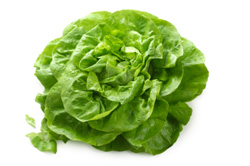Eating with a Conscience
Choosing organic food to protect health and the environment
View a different non-organic crop
 Lettuce
Lettuce
Below are the pesticides with established tolerances (residue limits for pesticides used in the U.S. or by countries exporting to the U.S.) for lettuce. While not all the pesticides on the list are applied to all lettuce, there is no way to tell which pesticides are applied to any given piece of conventional produce on your store shelf. You may consider talking to the farmers at your local farmers market about the pesticides they use, but eating organic is the only way to know for sure.
California Farmworker Poisonings, 1992–2010: 266 reported (CA acreage: 206,200). These poisoning incidents only represent the tip of the iceberg because it only reflects reported incidents in one state. It is widely recognized that pesticide incidents are underreported and often misdiagnosed.
Pesticide Tolerances —Health and Environmental Effects: The database shows that while lettuce grown with toxic chemicals show low pesticide residues on the finished commodity, there are 48 pesticides with established tolerance for lettuce, 24 are acutely toxic creating a hazardous environment for farmworkers, 42 are linked to chronic health problems (such as cancer), 14 contaminate streams or groundwater, and 40 are poisonous to wildlife.
Pollinator Impacts: In addition to habitat loss due to the expansion of agricultural and urban areas, the database shows that there are 22 pesticides used on lettuce that are considered toxic to honey bees and other insect pollinators. For more information on how to protect pollinators from pesticides, see Beyond Pesticides' BEE Protective webpage.
- This crop is NOT dependent on pollinators.
- This crop is NOT foraged by pollinators.
(A = acute health effects, C = chronic health effects, SW = surface water contaminant, GW = ground water contaminant, W = wildlife poison, B = bee poison, LT = long-range transport)
|
Acephate Benfluralin Bifenthrin Boscalid Buprofezin Carbaryl Chlorpyrifos Clethodim Crotoxyphos Cryolite Cyfluthrin | Cymoxanil Cypermethrin Cyprodinil Diazinon Dicloran (DCNA) Dimethoate Dimethomorph Endosulfan Esfenvalerate Fenhexamid Fludioxonil Folpet | Imidacloprid Iprodione Lambda-cyhalothrin Maneb Metalaxyl Metaldehyde Methamidophos Methomyl Methoxyfenozide Mevinphos Myclobutanil | Naled Paraquat/Paraquat dichloride Permethrin Phosphine Propyzamide Quinoxyfen Spiromesifen Tebufenozide Thiobencarb Tralomethrin Triflumizole |
All tolerance data is based on the Environmental Protection Agency's Tolerances and Exemptions for Pesticide Chemical Residues in Food located in the Electronic Code of Federal Regulations (eCFR). For more information, see our Methodology page.








